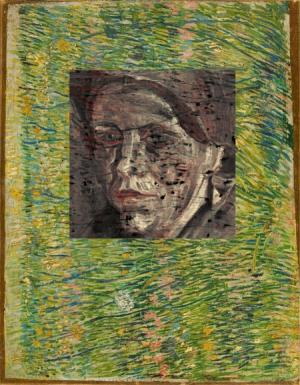|
Current News |
|
Chemistry A to Z |
|
About Internetchemistry |
|
- Imprint |
|
|
'Hidden' Van Gogh painting revealed |
|
A new technique allows pictures which were later painted over to be revealed once more. An international research team, including members from Delft University of Technology (The Netherlands) and the University of Antwerp (Belgium), has successfully applied this technique for the first time to the painting entitled Patch of Grass by Vincent van Gogh. Behind this painting is a portrait of a woman. |
|
It is well-known that Vincent van Gogh often painted over his older works. Experts estimate that about one third of his early paintings conceal other compositions under them. A new technique, based on synchrotron radiation induced X-ray fluorescence spectroscopy, reveals this type of hidden painting. The techniques usually used to reveal concealed layers of paintings, such as conventional X-ray radiography, have their limitations. Together with experts from the Deutsches Elektronen-Synchrotron in Hamburg and the Kröller-Müller Museum, TU Delft materials expert and art historian Dr Joris Dik, and University of Antwerp chemistry professor Koen Janssens therefore chose to adopt a different approach. The painting is subjected to an X-ray bundle from a synchrotron radiation source, and the fluorescence of the layers of paint is measured. This technique has the major advantage that the measured fluorescence is specific to each chemical element. Each type of atom (e.g. lead or mercury) and also individual paint pigments can therefore be charted individually. The benefit of using synchrotron radiation is that the upper layers of paint distort the measurements to a lesser degree. Moreover, the speed of measurement is high, which allows relatively large areas to be visualised. Patch of Grass This method was applied to a painting by Vincent van Gogh. The work in question, Patch of Grass, was painted by Van Gogh in Paris in 1887 and is owned by the Kröller-Müller Museum. Previous research had already discovered the vague outline of a head behind the painting. It was scanned at the synchrotron radiation source DORIS at Deutsches Elektronen-Synchrotron DESY in Hamburg using an intense but very small X-ray bundle. Over the course of two days, the area covering the image of a woman’s head was scanned, measuring 17.5 x 17.5 cm. The measurements enabled researchers to reconstruct the concealed painting in unparalleled detail. In particular the combination of the distribution of the elements mercury and antimony (from specific paint pigments) provided a 'colour photo' of the portrait which had been painted over. The reconstruction enables art historians to understand the evolution of Van Gogh’s work better. The applied technique is expected to pave the way for research into many other concealed paintings. |
|
|
|
|
Related topics - search form: |
|
|
